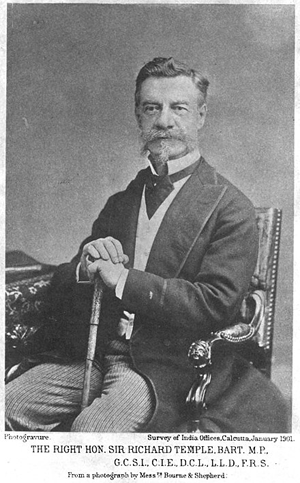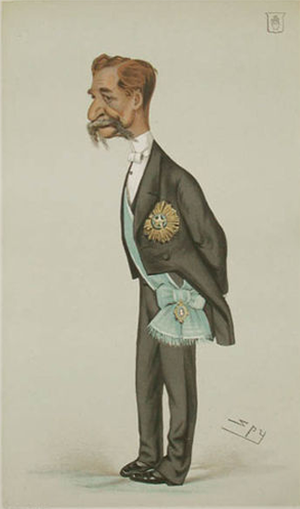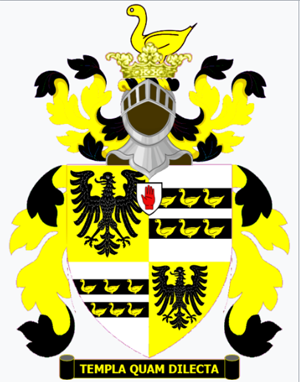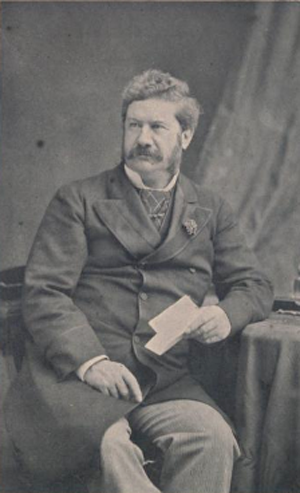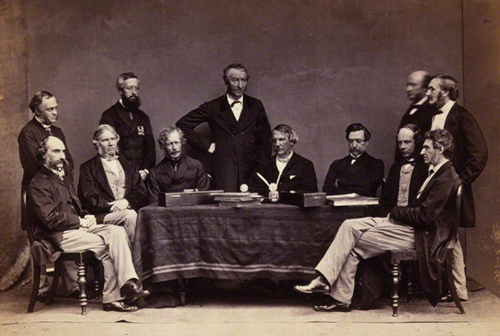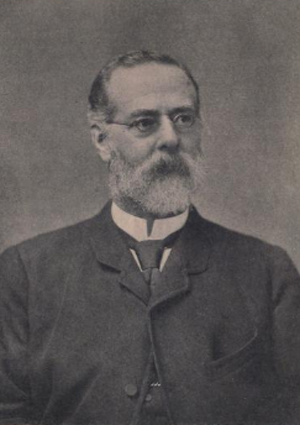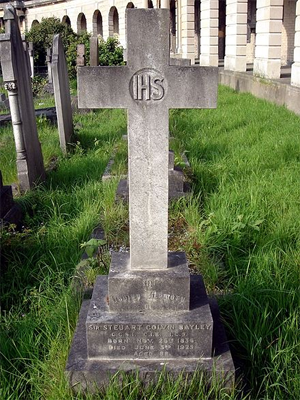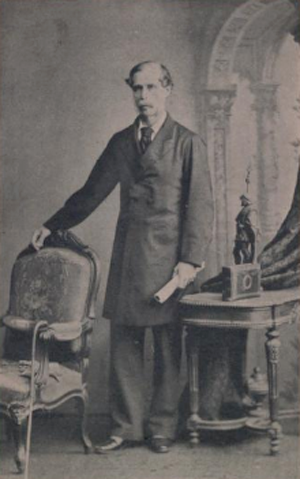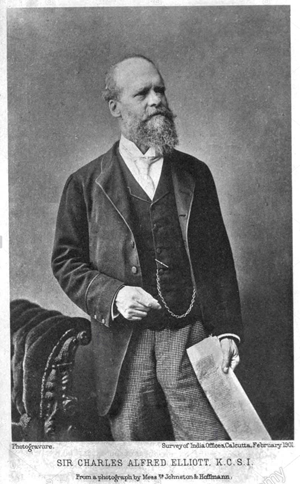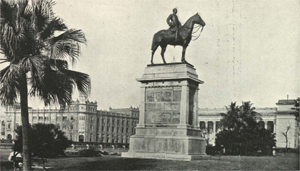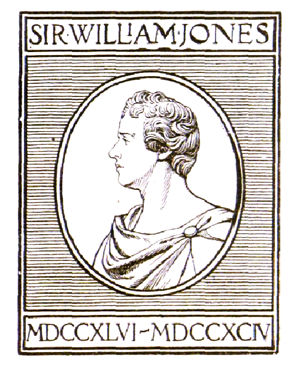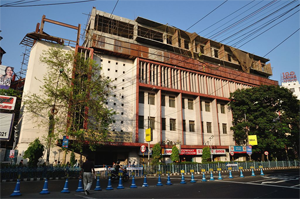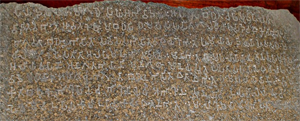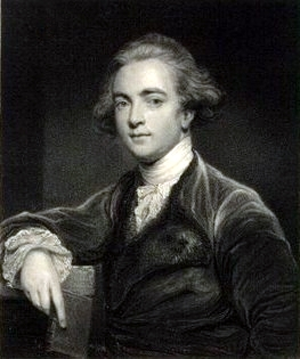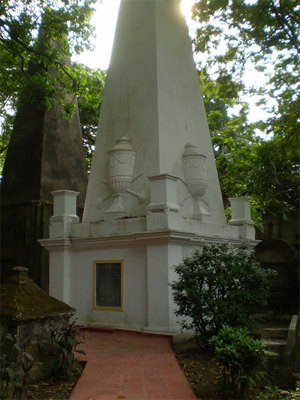Re: Freda Bedi, by Wikipedia
Indian Association for the Cultivation of Science
by Wikipedia
Accessed: 12/10/19
NOTICE: THIS WORK MAY BE PROTECTED BY COPYRIGHT
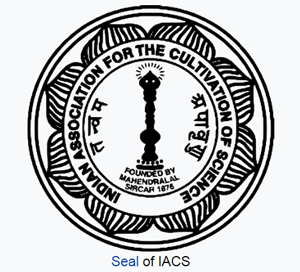
Indian Association for the Cultivation of Science
Seal of IACS
Motto: To cultivate Science in all its departments with a view to its advancement by original research and with a view to its varied application to the arts and comforts of life.
Type: Deemed University
Established: 29 July 1876
Founder: Dr. Mahendra Lal Sircar
Affiliation: UGC
President: Man Mohan Sharma
Director: Santanu Bhattacharya [1]
Location: 2A & 2B Raja S C Mullick Road Kolkata-700032, West Bengal, India
22.4983°N 88.3686°E
Campus: Urban
Website: http://www.iacs.res.in
Indian Association for the Cultivation of Science (IACS) is an institute of higher learning in Kolkata, India.[2][3] Established in 1876 by Mahendra Lal Sarkar, a private medical practitioner, it focuses on fundamental research in basic sciences.[4] It is India's oldest research institute [5][6] Located at Jadavpur, South Kolkata beside Jadavpur University, Central Glass and Ceramic Research Institute and Indian Institute of Chemical Biology it is spread over a limited area of 9.5 acres.[7]. In May 2018, the Ministry of Human Resource Development announced that IACS[8] had been granted the status of Deemed University[9] under De-novo Category under section 3 of the University Grants Commission (UGC) Act 1956.
Academic programme
The institute is engaged in fundamental research in various fields of physics, chemistry and chemical biology. It is one of the most active research institutes in India and publishes on an average ~ 500 research articles in peer reviewed journals including top journals like Physical Review Letters, Journal of American Chemical Society and Angew. Chem. Int. Ed. Recent interests include research in energy, fuel cells, nano materials like graphene and carbon nanotubes. The institute emphasizes PhD programmes, the degree being provided either by Jadavpur University or by University of Calcutta. There is also full-fledged Integrated PhD programme for post-Bachelor's students. From academic year 2005-2006 it started an integrated PhD programme in chemistry.[7] There are 8 departments in IACS, 4 units and 3 centres namely Materials Science, Solid state physics, Theoretical physics, Spectroscopy, Physical Chemistry, Inorganic Chemistry, Organic Chemistry, Biological Chemistry, Polymer Science unit, Energy research unit, Raman centre for atomic and molecular sciences, Centre for advanced materials, Center for Mathematical, Computational and Data Sciences, MLS Professor's unit and Director's Research Unit. After getting Deemed to be University status by UGC, the department structure has been replaced by School Structure. At present there are six schools namely School of Applied & Interdisciplinary Sciences, School of Biological Sciences, School of Chemical Sciences, School of Materials Sciences, School of Mathematical & Computational Sciences and School of Physical Sciences. There are about 70 working scientists in IACS. One important distinctive aspect of IACS is the presence of a majority of young scientist who are bringing new research areas and directions to IACS.
Nobel laureate Sir C. V. Raman did his groundbreaking work in Raman effect in this institute.[10] His work was first published in the Indian Journal of Physics, which is published by IACS.[11]
Apart from the works of C. V. Raman and K. S. Krishnan in Optics, IACS has produced several important paradigms in modern science. IACS has a very strong group in theoretical chemistry and quantum chemistry. Debashis Mukherjee developed the Mk-MRCC method to account for electron correlations in molecular systems which is considered as a "gold-standard" in computational chemistry. Another important discovery has been in the area of solvation dynamics of molecules and particular the dynamics of water molecules around the surfaces of membranes. These experiments performed by Professor Kankan Bhattacharyya have provided a fundamental insights into the behavior of water near biological surfaces and led to the coining of the word "biological water" in the physical chemistry community. Anirban Bandyopadhyay, who did his PhD at IACS went on to do research on neuroscience. Later at the Japanese National Institute for Materials Science, Anirban detected quantum states in microtubules that as per Orchestrated objective reduction play a key role in human consciousness.
Administration
At its inception, the IACS was headed by a President, with the Honorary Secretary responsible for the day-to-day running of the Society. Until 1911, the office of President was de facto held by the Lieutenant-Governor of Bengal, when the Lieutenant-Governor (Governor from 1912) became the co-patron of the Society alongside the Viceroy of India, whose office-holders were automatically Patrons of the Society until 1947.[12][note 1] Following India's independence in 1947, the administration of the IACS was reconstituted, with the designation of "Honorary Director" substituted for "Honorary Secretary."[13] The Director's prefix of "Honorary" was dropped in 1953.[14]
Presidents of the IACS (1876-present)
• Sir Richard Temple, 1st Baronet FRS (1876-1877)
• The Hon. Sir Ashley Eden FASB (1877-1882)
• Sir Augustus Rivers Thompson (1882-1887)
• Sir Steuart Bayley (1887-1890)
• Sir Charles Alfred Elliott FASB (1890-1895)
• Sir Alexander Mackenzie (1895-1898)
• Sir John Woodburn (1898-1903)
• Sir Andrew Henderson Leith Fraser FASB (1903-1909)
• Sir Edward Norman Baker (1909-1911)
• Raja Pyare Mohan Mukherjee FASB (1911-1922)[15]
• Hon. Justice Sir Ashutosh Mukherjee FASB, FRSE, FRAS, MRIA (1922-1924)[16]
• Sir Rajendra Nath Mookerjee FASB (1924-1934?)[17]
• Sir Nilratan Sircar (1934-1942)[18]
• Prof. Rai Bahadur Sir Upendranath Brahmachari FNI, FASB (1942-1946)[19][20]
• Prof. Meghnad Saha FNI, FASB, FRS (1946-1951)[20][21]
• Prof. Sir Jnan Chandra Ghosh FNI (1951-1954)[22][23]
• Hon. Justice Charu Chandra Biswas (1954-1957)[24]
• Hon. Chief Justice Phani Bhusan Chakravartti (1957-1958)[25]
• Prof. Satyendra Nath Bose FNI, FRS (1958-1962)[26][27]
• Hon. Justice Rama Prasad Mookerjee (1962-1965)[27]
• Prof. Jnanendra Nath Mukherjee FNI, FCS (1965-1968)[28]
• Prof. Basanti Dulal Nagchaudhuri FNA (first term, 1968-1970)[29][note 2]
• Prof. Sushil Kumar Mukherjee FNA (first term, 1970-1973)[30][31]
• Prof. Sukumar Chandra Sirkar FNA (1973-1974)[31]
• Prof. Basanti Dulal Nagchaudhuri FNA (second term, 1974-1977)[32][33]
• Prof. Bimal Kumar Bachhawat FNA (1977-1983)[33]
• Prof. Sushil Kumar Mukherjee FNA (second term, 1983-1997)[34][35]
• Prof. Arun Kumar Sharma FNA, FASc (1997-2000)[35]
• Prof. M. M. Chakraborty (2000-2003)[36][37]
• Prof. Ashesh Prosad Mitra FNA, FASc, FRS (2003-2007)[38]
• Prof. Shri Krishna Joshi FNA, FASc (2007-2014)[39]
• Prof. Man Mohan Sharma FNA, FASc, FRS, FREng (2014-present)[40]
Secretaries and Directors of the IACS
Honorary Secretaries of the IACS (1876-1947)
• Dr. Mahendralal Sarkar (Founder-Secretary, 1876-1904)[41]
• Dr. Amritalal Sarkar (1904-1919)[41][18]
• Prof. Sir C. V. Raman (1919-1933)[18]
• Prof. K. S. Krishnan (1933-June 1934)[18]
• Prof. Sisir Kumar Mitra (June 1934-November 1935)[18]
• Prof. Jnanendra Nath Mukherjee FNI, FCS (November 1935-April 1944)[42]
• Prof. Meghnad Saha FNI, FASB, FRS (April 1944-1945)[43][44]
• Prof. Priyadaranjan Ray FNI (1945-1947)[44]
Honorary Directors of the IACS (1947-1953)[edit]
• Prof. Priyadaranjan Ray FNI (1947-1953)[13][14]
Directors of the IACS (1953-present)
• Prof. Meghnad Saha FNI, FASB, FRS (1953-1956)[14][24]
• Prof. Priyadaranjan Ray FNI (officiating, 1956-1958)[24][26]
o Prof. Sukumar Chandra Sirkar FNI (acting, 1958-1959)[26][45]
• Prof. Kedareswar Banerjee FNI (1959-1965)[45][28]
o Prof. Bishwambhar Nath Srivastava FNI (acting, 1965-1968)[28][29]
• Prof. Debidas Basu (1968-1980)[29][46]
o G. S. Banerjee IAS (acting, September 1980-March 1981)[46]
• Prof. Sadhan Basu FNA, FASc (March 1981-August 1982, on medical leave from July)[46][34]
o G. S. Banerjee IAS (acting, July-December 1982)[34]
• Prof. Asok Kumar Barua FASc (December 1982-1989)[34]
• Prof. Usha Ranjan Ghatak FNA, FASc (1989-1993)[47]
• Prof. Dipankar Chakravorty FNA, FASc (1993-1999)[48]
• Prof. Debashis Mukherjee FNA, FASc (1999-2008)[49][50]
• Prof. Kankan Bhattacharyya FNA, FASc (2008-2013)[50][51]
o Prof. Subhas Chandra Roy (acting, February-September 2013)[51]
o Prof. Deb Shankar Ray FNA, FASc (acting, September 2013-April 2015)[52]
• Prof. Santanu Bhattacharya FNA, FASc (April 2015 - present)[40]
Notes
1. With the exceptions of Sir (later Lord) Antony MacDonnell (Lieutenant-Governor 1893-1895), Sir Charles Cecil Stevens (Lieutenant-Governor 1897-1898), James Bourdillon (Lieutenant-Governor 1902-1903), Sir Lancelot Hare (Lieutenant-Governor 1906) and Francis Slacke (Lieutenant-Governor 1906-1908).
2. Prior to 1970, the Indian National Science Academy was named the "National Institute of Sciences of India", and its fellows bore the post-nominal "FNI". The post-nominal became "FNA" in 1970 when the association adopted its present name.
References
1. "IACS director". iacs.res.in. Retrieved 8 October 2017.
2. Uma Dasgupta (2011). Science and Modern India: An Institutional History, C. 1784-1947. Pearson Education India. ISBN 9788131728185.
3. Bernhard Joseph Stern. Science and Society. p. 84.
4. "Indian Association for the Cultivation of Science, Kolkata". dst.gov.in. Retrieved 19 April 2014.
5. "saha.ac.in". Retrieved 8 October 2017.
6. "Indian Association for the Cultivation of Science". twas.org. Retrieved 19 April 2014.
7. "About IACS". iacs.res.in. Retrieved 19 April 2014.
8. Aswathi Pacha (13 February 2018). "IACS' new source of white light". The Hindu. Retrieved 14 July 2018.
9. Subhankar Chowdhury (3 June 2018). "Tag boost for research hub". The Telegraph. India. Retrieved 8 July 2018.
10. "Sir Venkata Raman - Biographical". nobelprize.org. Retrieved 19 April 2014.
11. "Indian Journal of Physics". springer.com. Retrieved 19 April 2014.
12. Report of the Indian Association for the Cultivation of Science for the Year 1915. Anglo-Sanskrit Press. 1915. p. 144.
13. The Indian Association for the Cultivation of Science: Annual Report for 1947-1948. 1948. pp. 25–26.
14. "The Indian Association for the Cultivation of Science: Annual Report for 1952-53" (PDF). Archive - IACS. Retrieved 7 October 2017.
15. Report of the Indian Association for the Cultivation of Science for the Year 1923. Anglo-Sanskrit Press. 1923. p. 11.
16. "IACS - Annual Report for the Year 1924" (PDF). Archive - IACS. Retrieved 7 October 2017.
17. Indian Association for the Cultivation of Science: Annual Report for the Year 1935. 1935. p. 1.
18. "Raman, Krishnan and the IACS Episodes of the 1930s" (PDF). INSA - Indian Journal of History of Science. Retrieved 7 October 2017.
19. Indian Association for the Cultivation of Science: Annual Report for the Year 1942. 1942. p. 20.
20. Indian Association for the Cultivation of Science: Annual Report for the Year 1946. 1946. p. 1.
21. "The Indian Association for the Cultivation of Science: Annual Report for 1950-51" (PDF). Archive - IACS. Retrieved 7 October 2017.
22. "The Indian Association for the Cultivation of Science: Annual Report for 1951-52" (PDF). Archive - IACS. Retrieved 7 October 2017.
23. Indian Association for the Cultivation of Science: Annual Report for 1953-54. 1954. p. 2.
24. Indian Association for the Cultivation of Science: Annual Report for 1955-56. 1956. p. 2.
25. Indian Association for the Cultivation of Science: Annual Report for 1957-58. 1958. p. 2.
26. Indian Association for the Cultivation of Science: Annual Report for 1958-59. 1959. p. 2.
27. Indian Association for the Cultivation of Science: Annual Report for 1961-62. 1962. p. 2.
28. Indian Association for the Cultivation of Science: Annual Report for 1965-66. 1966. pp. 2–4.
29. Indian Association for the Cultivation of Science: Annual Report for 1968-69. 1969. p. 1.
30. Indian Association for the Cultivation of Science: Annual Report for 1970-71. 1971. p. 1.
31. Indian Association for the Cultivation of Science: Annual Report for 1973-74. 1974. p. 1.
32. Indian Association for the Cultivation of Science: Annual Report for 1974-75. 1975. p. 1.
33. Indian Association for the Cultivation of Science: Annual Report for 1977-78. 1978. p. 1.
34. Indian Association for the Cultivation of Science: Annual Report for 1982-83. 1983. pp. 1–4.
35. Indian Association for the Cultivation of Science: Annual Report for 1997-98. IACS. 1998. p. 3.
36. Indian Association for the Cultivation of Science: Annual Report for 2000-2001. IACS. 2001. p. 3.
37. Indian Association for the Cultivation of Science: Annual Report for 2002-2003. IACS. 2003. p. 6.
38. Indian Association for the Cultivation of Science: Annual Report for 2003-2004. IACS. 2004. p. 1.
39. Indian Association for the Cultivation of Science: Annual Report for 2007-2008. IACS. 2008. pp. 8–11.
40. Indian Association for the Cultivation of Science: Annual Report for 2014-15. IACS. 2015. p. 11.
41. Report of the Indian Association for the Cultivation of Science for the Year 1904. Anglo-Sanskrit Press. 1904. p. 1.
42. The Indian Association for the Cultivation of Science: Annual Report for the Year 1943. 1943. p. 2.
43. The Indian Association for the Cultivation of Science: Annual Report for the Year 1944. 1944. p. 16.
44. The Indian Association for the Cultivation of Science: Annual Report for the Year 1945. 1945. p. 15.
45. Indian Association for the Cultivation of Science: Annual Report for 1959-60. IACS. 1960. p. 2.
46. Indian Association for the Cultivation of Science: Annual Report for 1980-81. IACS. 1981. p. 2.
47. Indian Association for the Cultivation of Science: Annual Report for 1989-90. IACS. 1990. p. 1.
48. Indian Association for the Cultivation of Science: Annual Report for 1992-93. IACS. 1992. p. 1.
49. Indian Association for the Cultivation of Science: Annual Report for 1999-2000. IACS. 2000. p. 1.
50. Indian Association for the Cultivation of Science: Annual Report for 2008-09. IACS. 2009. p. 7.
51. Indian Association for the Cultivation of Science: Annual Report for 2012-13. IACS. 2013. p. 9.
52. Indian Association for the Cultivation of Science: Annual Report for 2013-14. IACS. 2014. p. 11.
by Wikipedia
Accessed: 12/10/19
NOTICE: THIS WORK MAY BE PROTECTED BY COPYRIGHT
YOU ARE REQUIRED TO READ THE COPYRIGHT NOTICE AT THIS LINK BEFORE YOU READ THE FOLLOWING WORK, THAT IS AVAILABLE SOLELY FOR PRIVATE STUDY, SCHOLARSHIP OR RESEARCH PURSUANT TO 17 U.S.C. SECTION 107 AND 108. IN THE EVENT THAT THE LIBRARY DETERMINES THAT UNLAWFUL COPYING OF THIS WORK HAS OCCURRED, THE LIBRARY HAS THE RIGHT TO BLOCK THE I.P. ADDRESS AT WHICH THE UNLAWFUL COPYING APPEARED TO HAVE OCCURRED. THANK YOU FOR RESPECTING THE RIGHTS OF COPYRIGHT OWNERS.

Indian Association for the Cultivation of Science
Seal of IACS
Motto: To cultivate Science in all its departments with a view to its advancement by original research and with a view to its varied application to the arts and comforts of life.
Type: Deemed University
Established: 29 July 1876
Founder: Dr. Mahendra Lal Sircar
Affiliation: UGC
President: Man Mohan Sharma
Director: Santanu Bhattacharya [1]
Location: 2A & 2B Raja S C Mullick Road Kolkata-700032, West Bengal, India
22.4983°N 88.3686°E
Campus: Urban
Website: http://www.iacs.res.in
Indian Association for the Cultivation of Science (IACS) is an institute of higher learning in Kolkata, India.[2][3] Established in 1876 by Mahendra Lal Sarkar, a private medical practitioner, it focuses on fundamental research in basic sciences.[4] It is India's oldest research institute [5][6] Located at Jadavpur, South Kolkata beside Jadavpur University, Central Glass and Ceramic Research Institute and Indian Institute of Chemical Biology it is spread over a limited area of 9.5 acres.[7]. In May 2018, the Ministry of Human Resource Development announced that IACS[8] had been granted the status of Deemed University[9] under De-novo Category under section 3 of the University Grants Commission (UGC) Act 1956.
Academic programme
The institute is engaged in fundamental research in various fields of physics, chemistry and chemical biology. It is one of the most active research institutes in India and publishes on an average ~ 500 research articles in peer reviewed journals including top journals like Physical Review Letters, Journal of American Chemical Society and Angew. Chem. Int. Ed. Recent interests include research in energy, fuel cells, nano materials like graphene and carbon nanotubes. The institute emphasizes PhD programmes, the degree being provided either by Jadavpur University or by University of Calcutta. There is also full-fledged Integrated PhD programme for post-Bachelor's students. From academic year 2005-2006 it started an integrated PhD programme in chemistry.[7] There are 8 departments in IACS, 4 units and 3 centres namely Materials Science, Solid state physics, Theoretical physics, Spectroscopy, Physical Chemistry, Inorganic Chemistry, Organic Chemistry, Biological Chemistry, Polymer Science unit, Energy research unit, Raman centre for atomic and molecular sciences, Centre for advanced materials, Center for Mathematical, Computational and Data Sciences, MLS Professor's unit and Director's Research Unit. After getting Deemed to be University status by UGC, the department structure has been replaced by School Structure. At present there are six schools namely School of Applied & Interdisciplinary Sciences, School of Biological Sciences, School of Chemical Sciences, School of Materials Sciences, School of Mathematical & Computational Sciences and School of Physical Sciences. There are about 70 working scientists in IACS. One important distinctive aspect of IACS is the presence of a majority of young scientist who are bringing new research areas and directions to IACS.
Nobel laureate Sir C. V. Raman did his groundbreaking work in Raman effect in this institute.[10] His work was first published in the Indian Journal of Physics, which is published by IACS.[11]
Apart from the works of C. V. Raman and K. S. Krishnan in Optics, IACS has produced several important paradigms in modern science. IACS has a very strong group in theoretical chemistry and quantum chemistry. Debashis Mukherjee developed the Mk-MRCC method to account for electron correlations in molecular systems which is considered as a "gold-standard" in computational chemistry. Another important discovery has been in the area of solvation dynamics of molecules and particular the dynamics of water molecules around the surfaces of membranes. These experiments performed by Professor Kankan Bhattacharyya have provided a fundamental insights into the behavior of water near biological surfaces and led to the coining of the word "biological water" in the physical chemistry community. Anirban Bandyopadhyay, who did his PhD at IACS went on to do research on neuroscience. Later at the Japanese National Institute for Materials Science, Anirban detected quantum states in microtubules that as per Orchestrated objective reduction play a key role in human consciousness.
Administration
At its inception, the IACS was headed by a President, with the Honorary Secretary responsible for the day-to-day running of the Society. Until 1911, the office of President was de facto held by the Lieutenant-Governor of Bengal, when the Lieutenant-Governor (Governor from 1912) became the co-patron of the Society alongside the Viceroy of India, whose office-holders were automatically Patrons of the Society until 1947.[12][note 1] Following India's independence in 1947, the administration of the IACS was reconstituted, with the designation of "Honorary Director" substituted for "Honorary Secretary."[13] The Director's prefix of "Honorary" was dropped in 1953.[14]
Presidents of the IACS (1876-present)
• Sir Richard Temple, 1st Baronet FRS (1876-1877)
• The Hon. Sir Ashley Eden FASB (1877-1882)
• Sir Augustus Rivers Thompson (1882-1887)
• Sir Steuart Bayley (1887-1890)
• Sir Charles Alfred Elliott FASB (1890-1895)
• Sir Alexander Mackenzie (1895-1898)
• Sir John Woodburn (1898-1903)
• Sir Andrew Henderson Leith Fraser FASB (1903-1909)
• Sir Edward Norman Baker (1909-1911)
• Raja Pyare Mohan Mukherjee FASB (1911-1922)[15]
• Hon. Justice Sir Ashutosh Mukherjee FASB, FRSE, FRAS, MRIA (1922-1924)[16]
• Sir Rajendra Nath Mookerjee FASB (1924-1934?)[17]
• Sir Nilratan Sircar (1934-1942)[18]
• Prof. Rai Bahadur Sir Upendranath Brahmachari FNI, FASB (1942-1946)[19][20]
• Prof. Meghnad Saha FNI, FASB, FRS (1946-1951)[20][21]
• Prof. Sir Jnan Chandra Ghosh FNI (1951-1954)[22][23]
• Hon. Justice Charu Chandra Biswas (1954-1957)[24]
• Hon. Chief Justice Phani Bhusan Chakravartti (1957-1958)[25]
• Prof. Satyendra Nath Bose FNI, FRS (1958-1962)[26][27]
• Hon. Justice Rama Prasad Mookerjee (1962-1965)[27]
• Prof. Jnanendra Nath Mukherjee FNI, FCS (1965-1968)[28]
• Prof. Basanti Dulal Nagchaudhuri FNA (first term, 1968-1970)[29][note 2]
• Prof. Sushil Kumar Mukherjee FNA (first term, 1970-1973)[30][31]
• Prof. Sukumar Chandra Sirkar FNA (1973-1974)[31]
• Prof. Basanti Dulal Nagchaudhuri FNA (second term, 1974-1977)[32][33]
• Prof. Bimal Kumar Bachhawat FNA (1977-1983)[33]
• Prof. Sushil Kumar Mukherjee FNA (second term, 1983-1997)[34][35]
• Prof. Arun Kumar Sharma FNA, FASc (1997-2000)[35]
• Prof. M. M. Chakraborty (2000-2003)[36][37]
• Prof. Ashesh Prosad Mitra FNA, FASc, FRS (2003-2007)[38]
• Prof. Shri Krishna Joshi FNA, FASc (2007-2014)[39]
• Prof. Man Mohan Sharma FNA, FASc, FRS, FREng (2014-present)[40]
Secretaries and Directors of the IACS
Honorary Secretaries of the IACS (1876-1947)
• Dr. Mahendralal Sarkar (Founder-Secretary, 1876-1904)[41]
• Dr. Amritalal Sarkar (1904-1919)[41][18]
• Prof. Sir C. V. Raman (1919-1933)[18]
• Prof. K. S. Krishnan (1933-June 1934)[18]
• Prof. Sisir Kumar Mitra (June 1934-November 1935)[18]
• Prof. Jnanendra Nath Mukherjee FNI, FCS (November 1935-April 1944)[42]
• Prof. Meghnad Saha FNI, FASB, FRS (April 1944-1945)[43][44]
• Prof. Priyadaranjan Ray FNI (1945-1947)[44]
Honorary Directors of the IACS (1947-1953)[edit]
• Prof. Priyadaranjan Ray FNI (1947-1953)[13][14]
Directors of the IACS (1953-present)
• Prof. Meghnad Saha FNI, FASB, FRS (1953-1956)[14][24]
• Prof. Priyadaranjan Ray FNI (officiating, 1956-1958)[24][26]
o Prof. Sukumar Chandra Sirkar FNI (acting, 1958-1959)[26][45]
• Prof. Kedareswar Banerjee FNI (1959-1965)[45][28]
o Prof. Bishwambhar Nath Srivastava FNI (acting, 1965-1968)[28][29]
• Prof. Debidas Basu (1968-1980)[29][46]
o G. S. Banerjee IAS (acting, September 1980-March 1981)[46]
• Prof. Sadhan Basu FNA, FASc (March 1981-August 1982, on medical leave from July)[46][34]
o G. S. Banerjee IAS (acting, July-December 1982)[34]
• Prof. Asok Kumar Barua FASc (December 1982-1989)[34]
• Prof. Usha Ranjan Ghatak FNA, FASc (1989-1993)[47]
• Prof. Dipankar Chakravorty FNA, FASc (1993-1999)[48]
• Prof. Debashis Mukherjee FNA, FASc (1999-2008)[49][50]
• Prof. Kankan Bhattacharyya FNA, FASc (2008-2013)[50][51]
o Prof. Subhas Chandra Roy (acting, February-September 2013)[51]
o Prof. Deb Shankar Ray FNA, FASc (acting, September 2013-April 2015)[52]
• Prof. Santanu Bhattacharya FNA, FASc (April 2015 - present)[40]
Notes
1. With the exceptions of Sir (later Lord) Antony MacDonnell (Lieutenant-Governor 1893-1895), Sir Charles Cecil Stevens (Lieutenant-Governor 1897-1898), James Bourdillon (Lieutenant-Governor 1902-1903), Sir Lancelot Hare (Lieutenant-Governor 1906) and Francis Slacke (Lieutenant-Governor 1906-1908).
2. Prior to 1970, the Indian National Science Academy was named the "National Institute of Sciences of India", and its fellows bore the post-nominal "FNI". The post-nominal became "FNA" in 1970 when the association adopted its present name.
References
1. "IACS director". iacs.res.in. Retrieved 8 October 2017.
2. Uma Dasgupta (2011). Science and Modern India: An Institutional History, C. 1784-1947. Pearson Education India. ISBN 9788131728185.
3. Bernhard Joseph Stern. Science and Society. p. 84.
4. "Indian Association for the Cultivation of Science, Kolkata". dst.gov.in. Retrieved 19 April 2014.
5. "saha.ac.in". Retrieved 8 October 2017.
6. "Indian Association for the Cultivation of Science". twas.org. Retrieved 19 April 2014.
7. "About IACS". iacs.res.in. Retrieved 19 April 2014.
8. Aswathi Pacha (13 February 2018). "IACS' new source of white light". The Hindu. Retrieved 14 July 2018.
9. Subhankar Chowdhury (3 June 2018). "Tag boost for research hub". The Telegraph. India. Retrieved 8 July 2018.
10. "Sir Venkata Raman - Biographical". nobelprize.org. Retrieved 19 April 2014.
11. "Indian Journal of Physics". springer.com. Retrieved 19 April 2014.
12. Report of the Indian Association for the Cultivation of Science for the Year 1915. Anglo-Sanskrit Press. 1915. p. 144.
13. The Indian Association for the Cultivation of Science: Annual Report for 1947-1948. 1948. pp. 25–26.
14. "The Indian Association for the Cultivation of Science: Annual Report for 1952-53" (PDF). Archive - IACS. Retrieved 7 October 2017.
15. Report of the Indian Association for the Cultivation of Science for the Year 1923. Anglo-Sanskrit Press. 1923. p. 11.
16. "IACS - Annual Report for the Year 1924" (PDF). Archive - IACS. Retrieved 7 October 2017.
17. Indian Association for the Cultivation of Science: Annual Report for the Year 1935. 1935. p. 1.
18. "Raman, Krishnan and the IACS Episodes of the 1930s" (PDF). INSA - Indian Journal of History of Science. Retrieved 7 October 2017.
19. Indian Association for the Cultivation of Science: Annual Report for the Year 1942. 1942. p. 20.
20. Indian Association for the Cultivation of Science: Annual Report for the Year 1946. 1946. p. 1.
21. "The Indian Association for the Cultivation of Science: Annual Report for 1950-51" (PDF). Archive - IACS. Retrieved 7 October 2017.
22. "The Indian Association for the Cultivation of Science: Annual Report for 1951-52" (PDF). Archive - IACS. Retrieved 7 October 2017.
23. Indian Association for the Cultivation of Science: Annual Report for 1953-54. 1954. p. 2.
24. Indian Association for the Cultivation of Science: Annual Report for 1955-56. 1956. p. 2.
25. Indian Association for the Cultivation of Science: Annual Report for 1957-58. 1958. p. 2.
26. Indian Association for the Cultivation of Science: Annual Report for 1958-59. 1959. p. 2.
27. Indian Association for the Cultivation of Science: Annual Report for 1961-62. 1962. p. 2.
28. Indian Association for the Cultivation of Science: Annual Report for 1965-66. 1966. pp. 2–4.
29. Indian Association for the Cultivation of Science: Annual Report for 1968-69. 1969. p. 1.
30. Indian Association for the Cultivation of Science: Annual Report for 1970-71. 1971. p. 1.
31. Indian Association for the Cultivation of Science: Annual Report for 1973-74. 1974. p. 1.
32. Indian Association for the Cultivation of Science: Annual Report for 1974-75. 1975. p. 1.
33. Indian Association for the Cultivation of Science: Annual Report for 1977-78. 1978. p. 1.
34. Indian Association for the Cultivation of Science: Annual Report for 1982-83. 1983. pp. 1–4.
35. Indian Association for the Cultivation of Science: Annual Report for 1997-98. IACS. 1998. p. 3.
36. Indian Association for the Cultivation of Science: Annual Report for 2000-2001. IACS. 2001. p. 3.
37. Indian Association for the Cultivation of Science: Annual Report for 2002-2003. IACS. 2003. p. 6.
38. Indian Association for the Cultivation of Science: Annual Report for 2003-2004. IACS. 2004. p. 1.
39. Indian Association for the Cultivation of Science: Annual Report for 2007-2008. IACS. 2008. pp. 8–11.
40. Indian Association for the Cultivation of Science: Annual Report for 2014-15. IACS. 2015. p. 11.
41. Report of the Indian Association for the Cultivation of Science for the Year 1904. Anglo-Sanskrit Press. 1904. p. 1.
42. The Indian Association for the Cultivation of Science: Annual Report for the Year 1943. 1943. p. 2.
43. The Indian Association for the Cultivation of Science: Annual Report for the Year 1944. 1944. p. 16.
44. The Indian Association for the Cultivation of Science: Annual Report for the Year 1945. 1945. p. 15.
45. Indian Association for the Cultivation of Science: Annual Report for 1959-60. IACS. 1960. p. 2.
46. Indian Association for the Cultivation of Science: Annual Report for 1980-81. IACS. 1981. p. 2.
47. Indian Association for the Cultivation of Science: Annual Report for 1989-90. IACS. 1990. p. 1.
48. Indian Association for the Cultivation of Science: Annual Report for 1992-93. IACS. 1992. p. 1.
49. Indian Association for the Cultivation of Science: Annual Report for 1999-2000. IACS. 2000. p. 1.
50. Indian Association for the Cultivation of Science: Annual Report for 2008-09. IACS. 2009. p. 7.
51. Indian Association for the Cultivation of Science: Annual Report for 2012-13. IACS. 2013. p. 9.
52. Indian Association for the Cultivation of Science: Annual Report for 2013-14. IACS. 2014. p. 11.
